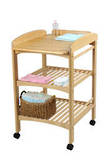Shop
01533
https://www.under5s.co.nz/shop/Hot+Topics+Articles/Health+%26+Wellbeing/NICU+common+terms+explained.html
NICU common terms explained
|
NICU (neonatal intensive care unit) is an intensive care unit designed with special equipment to care for premature or seriously ill newborn babies. It can be a daunting place the first time you visit either your own baby or someone else’s. Here we’ll explain some of the common terms and equipment used by the medical team to help guide you through.
|
You might also be interested in ...
Nappy Time Check List
Not all babies enjoy having their nappies changed! So to make life easier for both of you, be as organised as you can and have everything to hand. Use our Check List to help you!
When kids prefer one parent over the other
Preferring one parent to the other is a normal stage of your kids development. While this can be quite hurtful for the parent who is being excluded, it is helpful to remember that it is usually just a phase which will pass soon enough. Find out what can you do when your kids tend to prefer one parent over the other.
join usJoin us on social media for all our latest news. |
sign upSign up and receive our latest newsletters. |
|







NICU (neonatal intensive care unit) is an intensive care unit designed with special equipment to care for premature babies or seriously ill newborn babies.
It can be a daunting place the first time you visit the unit, either because of your own baby or someone else’s. There's likely to be lots of unfamiliar equipment and medical terms you may never have heard of before.NICU common terms explained
Here are some of the more common terms or words you may come across when visiting a NICU unit.
Anaemia
Apnoea
Aspiration
Bagging
Bilirubin
Bilirubin lights (bili lights)
Blood gas
Bradycardia
Cardio respiratory monitor
Catheter
Chest tube
Continuous Positive Airway Pressure (CPAP)
Culture
Cyanosis
Edema
Electrode
Electrolytes
Endotracheal tube (ET tube)
Extubation
Gavage feeding
Gestational age
High frequency ventilation (HFV)
Hyaline membrane disease (HMD)
Hydrocephalus
Hypoxia
Incubator/Humidicrib/Isolette
Intravenous Fluid, Lines and Pump
Intravenous line (IV)
Intraventricular hemorrhage (IVH)
Intubation
Jaundice
Kangaroo Care/Kangaroo Cuddles
Meconium
Meconium aspiration syndrome
Nasal Canula
Nasogastric tube (NG tube)
Necrotizing Enterocolitis (NEC)
Neonate
Neonatologist
Oscillator
Oxygen Saturation
Patent Ductus Arteriosus (PDA)
Peripherally Inserted Central Catheter (PICC)
Persistent Pulmonary Hypertension of Newborns (PPHN)
Phototherapy Lights
Pneumothorax (pneumo)
Pulse Oximetre
Respiratory Distress Syndrome (RDS)
Retinopathy Of Prematurity (ROP)
Room air
Sepsis
Spinal tap
Surfactant
Transient Tachypnea of the Newborn (TTN)
Umbilical Catheter, Arterial or Venous (UAC, UVC)
Ventilator
Ventricles of the brain
More premature baby articles to enjoy
Source: Early Buds - supporting kiwi parents of premature babies who spend time in NICU or SCBU.